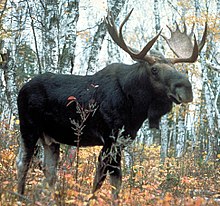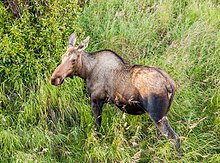Moose
A moose (Alces alces; called elk in Europe) is a large deer. Some authorities put the American moose in a different species, Alces americanus.
| Moose | |
|---|---|

| |
| Male (bull) | |

| |
| Female (cow) | |
| Scientific classification | |
| Domain: | Eukaryota |
| Kingdom: | Animalia |
| Phylum: | Chordata |
| Class: | Mammalia |
| Order: | Artiodactyla |
| Family: | Cervidae |
| Subfamily: | Capreolinae |
| Genus: | Alces Gray, 1821 |
| Species: | A. alces
|
| Binomial name | |
| Alces alces | |

| |
| Moose range map | |
| Synonyms | |
|
Cervus alces Linnaeus, 1758 | |
A male moose is called a bull, a female moose is called a cow, and a young moose is called a calf. A group of moose is called a herd. The plural form of moose is "moose”.[4]
Moose live in northern Europe, Asia, and in North America. Moose live mainly in the taiga forest, especially in areas with lakes, marshes and swamps. They also live in mountain ranges.
Range
changeMoose live in North America and also range from northern Europe to Siberia. In Europe they live in Finland, Sweden, Norway, Poland and the Baltic countries (Estonia, Latvia and Lithuania). In North America they live in Canada, Alaska and northern parts of the United States. In 2008 they were re-introduced to Scottish Highlands from Scandinavia.
Population
changeThere are about 115,000 moose in Finland, and about the same number in Norway. Alaska has about 200,000. Canada and Russia each have between 500,000 and one million. There are also some in the continental United States. The animal is widely distributed.
Life
changeMoose are active during the day. They live alone, but in winter they sometimes form small groups. Moose eat grass, leaves, twigs, willow, birch, maple shoots and water plants. After a pregnancy of 8 months, the female gives birth to one or two calves. Females can first become pregnant when they are between two and three years old. Young moose stay with their mother for a year; after one year they leave and live alone. Moose usually live to fifteen years old, but they can reach as old as twenty-seven years old. A mother moose will aggressively protect her young. Moose calves are hunted by bears and wolves.
Predators
changeA full-grown moose has few natural enemies. Siberian tigers prey on adult moose.[5][6] Wolves also pose a threat, especially to females with calves.[7] Brown bears are known to prey on moose, although bears are more likely to take over a wolf kill or to take young moose than to hunt adult moose on their own.[8] American black bears and cougars can take moose calves and can sometimes kill adult cows.[9][10] Wolverine are most likely to eat moose as carrion but have killed moose, including adults, when the moose are weakened by harsh winter conditions.[11] Killer whales are the moose's only known marine predator. They have been known to prey on moose swimming between islands off North America's northwest coast.[12]
Moose and humans
changeMoose have been hunted by humans since the Stone Age.
Because of their dark coloured fur, moose are hard to see when they are crossing roads at night. They are sometimes hit by cars. In some countries like Canada, Finland and Sweden there are moose warning signs on roads and motorways are fenced.
References
change- ↑ "I giacimenti quaternari di vertebrati fossili nell'Italia nord-orientale". Memorie di Scienze Geologiche. 43. January 1991.
- ↑ "Alces alces Linnaeus 1758 (moose)". PBDB. Archived from the original on 2020-08-04.
- ↑ Hundertmark, K. (2016). "Alces alces". IUCN Red List of Threatened Species. 2016: e.T56003281A22157381. doi:10.2305/IUCN.UK.2016-1.RLTS.T56003281A22157381.en.
- ↑ "moose Meaning in the Cambridge English Dictionary". dictionary.cambridge.org. Retrieved 2017-03-15.
- ↑ Frasef, A. (2012). Feline Behaviour and Welfare. CABI. pp. 72–77. ISBN 978-1-84593-926-7.
- ↑ Tigris Foundation dedicated to the survival of the Amur tiger and leopard in the wild : UK HOME Archived 2011-08-17 at the Wayback Machine. Tigrisfoundation.nl 1999. Retrieved on 2011-01-09.
- ↑ Nancy Long / Kurt Savikko (2007). "Wolf: Wildlife Notebook Series – Alaska Department of Fish and Game". Adfg.state.ak.us. Archived from the original on 2010-11-15. Retrieved 2009-11-27.
- ↑ Nancy Long / Kurt Savikko (2009). "Brown Bear: Wildlife Notebook Series – Alaska Department of Fish and Game". Adfg.state.ak.us. Retrieved 2009-11-27.
- ↑ Charles C. Schwartz and Albert W. Franzmann (1983). "Effects of tree crushing on black bear predation on moose calves" (PDF). Bears: Their Biology and Management. 5. A selection of papers from the Fifth International Conference on Bear Research and Management, Madison, Wisconsin, USA 1980: 40–44. doi:10.2307/3872518. ISSN 1936-0614. JSTOR 3872518. Archived from the original (PDF) on 2008-12-17. Retrieved 2014-10-25.
- ↑ "Hinterland Who's Who – Cougar". Hww.ca. Archived from the original on 2010-09-26. Retrieved 2009-11-27.
- ↑ "Gulo gulo – The American Society of Mammalogists" (PDF). smith.edu. Archived from the original (PDF) on 2012-06-17. Retrieved 2012-06-22.
- ↑ Robert W. Baird; Robin W. Baird (2006). Killer whales of the world: natural history and conservation. Voyageur Press. pp. 23–. ISBN 978-0-7603-2654-1. Retrieved 2011-02-02.
Other websites
changeMedia related to Alces alces at Wikimedia Commons
- goMoose
- "Warmer winters bedevil moose in Minnesota". USA Today. March 1, 2013.
